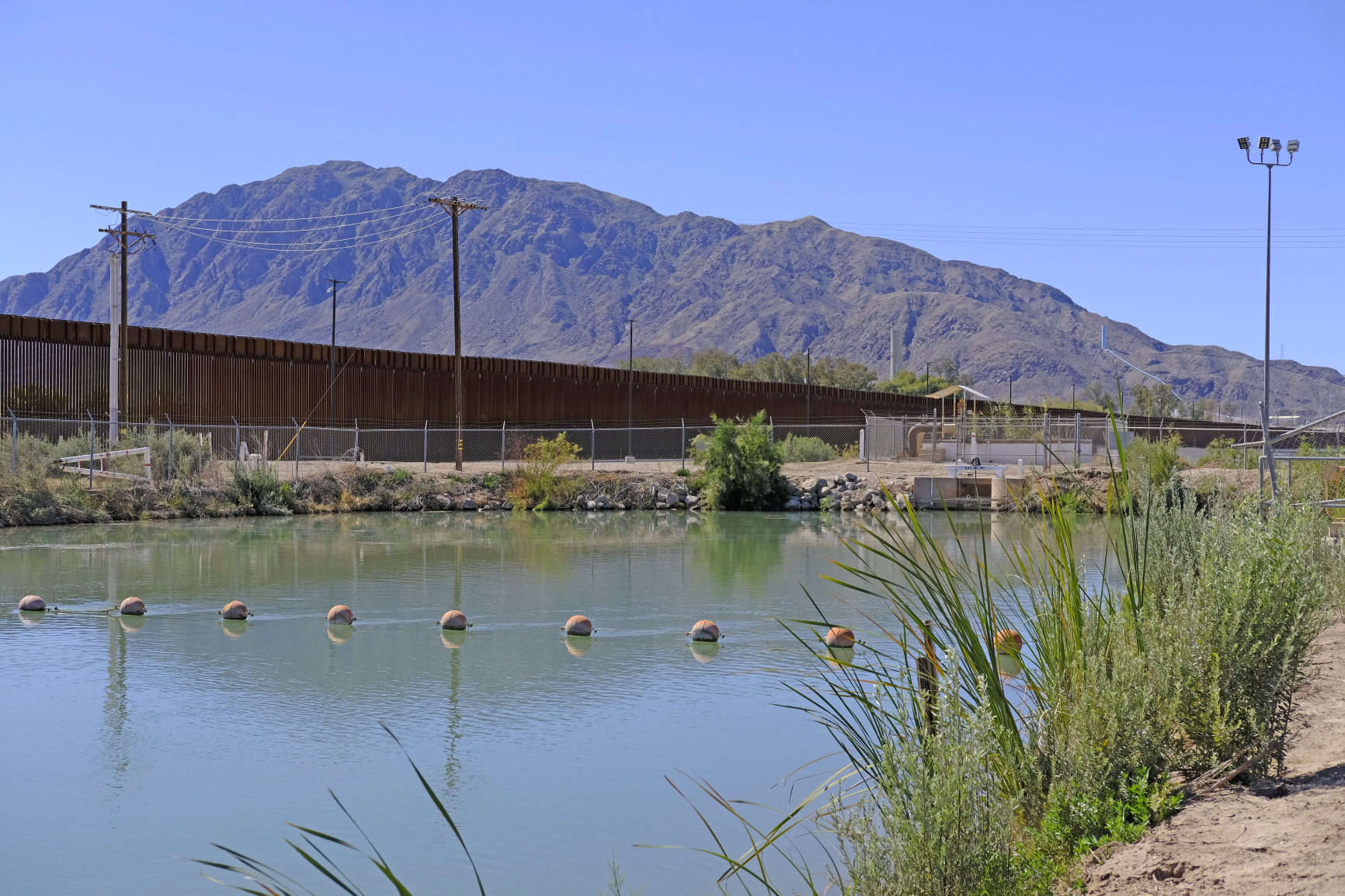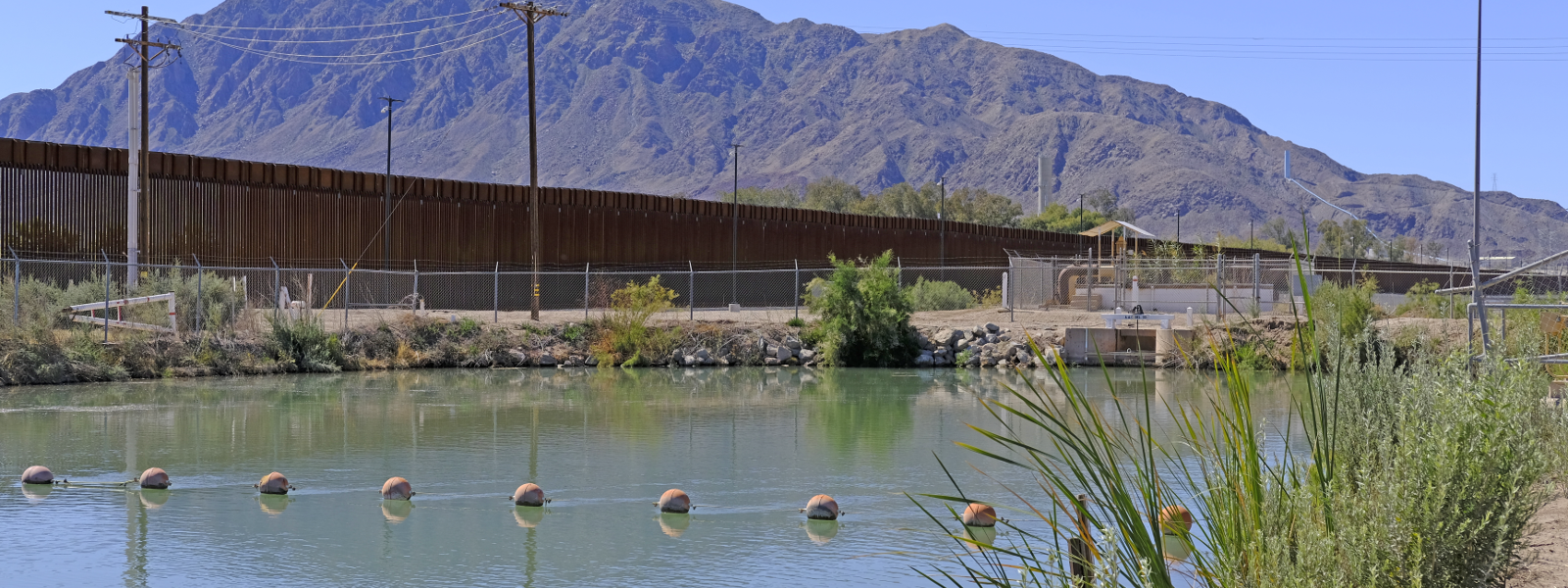California agrees to lasting cuts to Colorado River use

The All-American Canal runs along the U.S.-Mexico border and delivers water from the Colorado River to the Imperial Valley. Farmers in the valley use most of California’s entitlement to the river.
Photo/Caleb Hampton

By Caleb Hampton
California has agreed to make long-term cuts to the amount of water the state uses from the Colorado River, according to a proposed plan for managing the river released earlier this month by California, Nevada and Arizona.
The U.S. Bureau of Reclamation and the seven states in the Colorado River Basin, as well as 30 tribes and Mexico, are negotiating a plan to protect the river after a decades-long megadrought depleted flows and left key reservoirs Lake Mead and Lake Powell in danger of running dry.
Under the Lower Basin states’ proposal, which would take effect after 2026 and potentially last decades, California would forfeit about 10% of its allocation in most conditions, with Nevada giving up 17% and Arizona 27%. Mexico, if it agreed, would reduce its use by 17%. The reductions would apply when a range of reservoirs along the river are between 38% and 58% full. They would conserve a total of about 1.5 million acre-feet of water per year.
“It’s a matter of trying to thread the needle between ensuring that we have a long-term viable water supply in the Colorado River and respecting the water rights of the states and agencies,” said Tina Shields, Imperial Irrigation District water manager, who has been involved in the talks about the river’s future management.
The river supplies water to 40 million people in the West and irrigates more than 5 million acres of farmland.
California, the water rights of which are senior to those of other states, is entitled to the largest share of the river. The state is allocated 4.4 million acre-feet of water per year, about a third of the river’s total supplies. Farmers in the Imperial Valley, who are entitled to 3.1 million acre-feet per year, use most of the state’s Colorado River water to irrigate alfalfa, winter vegetables and other crops.
If river reservoir levels were to fall below 38% full, it would trigger steeper cuts on a sliding scale. In that scenario, which would conserve up to 3.9 million acre-feet per year, Upper Basin states would also face reductions.
If reservoirs filled to 58% of capacity, Lower Basin states would face smaller cuts. At 68% full, no water reductions would be enforced. Lake Mead, the largest reservoir on the river and in the country, is currently 37% full, well below its historic average but not as low as a couple years ago.
“Implementing our alternative will be extraordinarily difficult. It will represent billions of dollars in investments to manage the reductions,” J.B. Hamby, California’s Colorado River commissioner and vice president of the IID board of directors, said at a briefing this month. “We’re proposing it anyway, because that’s what we must do if we want a sustainable Colorado River Basin for future generations.”
A competing proposal from Colorado, Wyoming, Utah and New Mexico would base mandatory reductions on the levels of Lake Mead and Lake Powell, without factoring in the levels of smaller reservoirs, and would spare those states any cuts even in the most dire circumstance.
Federal officials and negotiators on both sides of the debate said they will continue talks to try to reach a consensus.
“We very much want to keep the system out of long-term litigation,” Shields said.
The Lower Basin states, including California, have yet to hold intrastate discussions to determine how much of their allocation individual water users, such as IID, would conserve under the scenarios considered in their proposal.
“We recognize that they’re not going to solve the structural debts on the Colorado River without participation from agriculture,” said Imperial Valley farmer Larry Cox. “More than likely, that means participation from Imperial Valley. But we would prefer not to have it mandated to us.”
Because of the seniority of the Imperial Valley’s water rights, the region has so far shared and conserved water through voluntary programs that compensate farmers for water savings, allowing growers to make economic decisions on whether to participate.
Since 2003, IID has transferred 16% of the valley’s entitlement to cities such as San Diego in exchange for funding to install water-saving irrigation systems. More than 70% of the Imperial Valley’s farm acreage participates in that “on-farm” conservation program funded through IID’s water transfers to urban water districts.
From this year through the end of 2026, Imperial Valley growers aim to conserve an additional 8% of their allocation through federally funded programs that are part of a short-term plan to manage the river. In total, the Lower Basin states plan to conserve around 3 million acre-feet of water over three years.
In the Imperial Valley, the programs could cost more than half a billion dollars, with the federal government paying IID $776 per acre-foot of water saved. The funds would be used to manage the programs, compensate farmers and improve irrigation infrastructure.
IID is awaiting authorization from state and federal wildlife agencies to finalize two programs it plans to use to conserve water through 2026.
One program would use the funds to expand on-farm conservation efforts by compensating farmers at a higher rate to install efficient irrigation systems. The other program would pay farmers to stop irrigating alfalfa for 45-60 days during the summer. That program would sacrifice some hay cuttings without killing the perennial crop.
Farmers had hoped to have a green light for those programs early this year. But wildlife agencies raised concerns that the water conservation could result in habitat loss for two endangered species, the desert pupfish and the clapper rail bird, which live in the drainage ditches and wetlands at the edge of the Salton Sea. The inland sea has been fed for decades by irrigation runoff and is shrinking as farmers cut back on water use.
The wildlife agencies have requested a formal biological consultation to determine the potential impact of agricultural water conservation on those species.
“It’s been a little frustrating,” Shields said, referring to the length of the environmental review process. She added that getting environmental authorization for a water transfer that large might typically take around two years, “but we also know that this is a short-term commitment.”
The federal government has allocated $250 million from the Inflation Reduction Act to fund habitat restoration at the Salton Sea in exchange for the region’s Colorado River conservation efforts.
Shields said she hopes the environmental review will conclude by April or May, in time for farmers to take advantage this year of a deficit-irrigation program that would run between June and September.
“Obviously, we had some conservation goals that we will not be meeting this year because of the delayed implementation,” she said. “We’re going to do the best we can, and certainly our growers have committed to do what they can as soon as they’re allowed to move forward.”
Federal officials said those conservation plans and above-average precipitation over the past two winters have lessened the near-term risk of reservoirs sinking to critically low levels.
For the Imperial Valley, the next three years could be a roadmap for the region’s role in long-term management of the Colorado River. “We’re going to learn a lot from our near-term conservation plans,” Shields said.
Farmers said their primary concerns for long-term management of the river are to ensure their senior water rights are protected, be compensated for conservation and avoid programs that take farmland out of production.
“Fallowing would have to be a last resort, and if it ever were used, it would need some conditions on it so that we don’t dry up the Imperial Valley,” said Mark McBroom, who grows alfalfa, citrus and other crops in Calipatria and chairs IID’s Agricultural Water Advisory Committee.
The Imperial Valley’s economy depends on its agriculture sector, which generates nearly $3 billion a year and employs one-sixth of Imperial County’s workforce. For that reason, “Fallowing is kind of the F-word for us,” McBroom said.
Growers said there is still room to save a lot of water through land leveling and installation of more efficient irrigation infrastructure such as pump-back systems, sprinklers and drip irrigation.
“There are more things we could do, but it doesn’t make economic sense to do it under the current funding mechanism,” said Cox, who grows alfalfa, lettuce, onions and other crops in Brawley, referring to compensation rates under the San Diego water transfer. He added that with the rising cost of materials and labor, it has become more expensive to install new irrigation systems.
In discussing California’s long-term commitments, Shields said the Imperial Valley “certainly would not want to agree to any long-term reductions” because of its “untouchable” water rights, but would instead look to save water through partnerships with other water users and compensated conservation programs.
“The water rights priority systems are going to be an important calculus as we start to break up those reductions on an agency-by-agency basis,” she said.
(Caleb Hampton is an assistant editor of Ag Alert. He may be contacted at champton@cfbf.com.)




